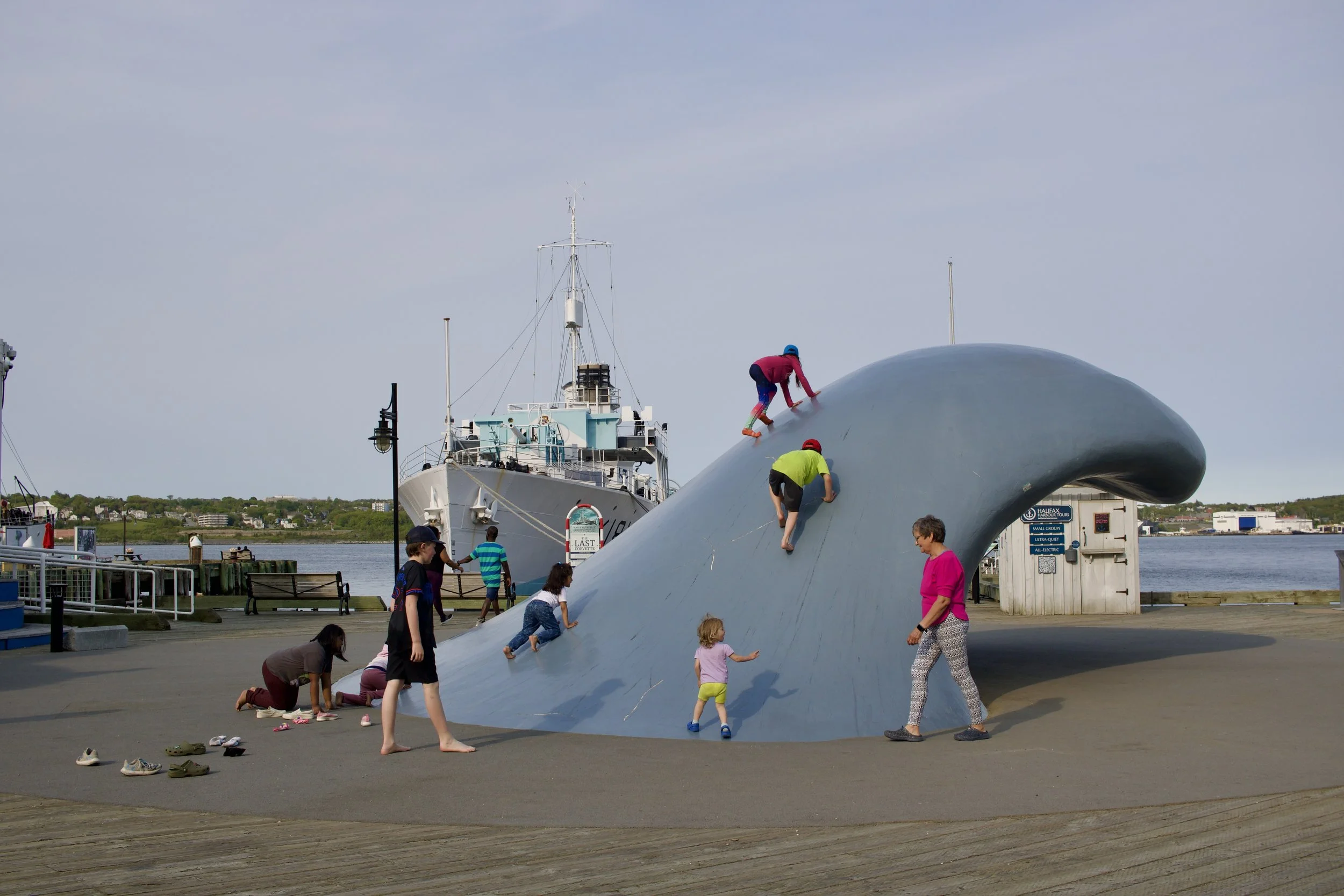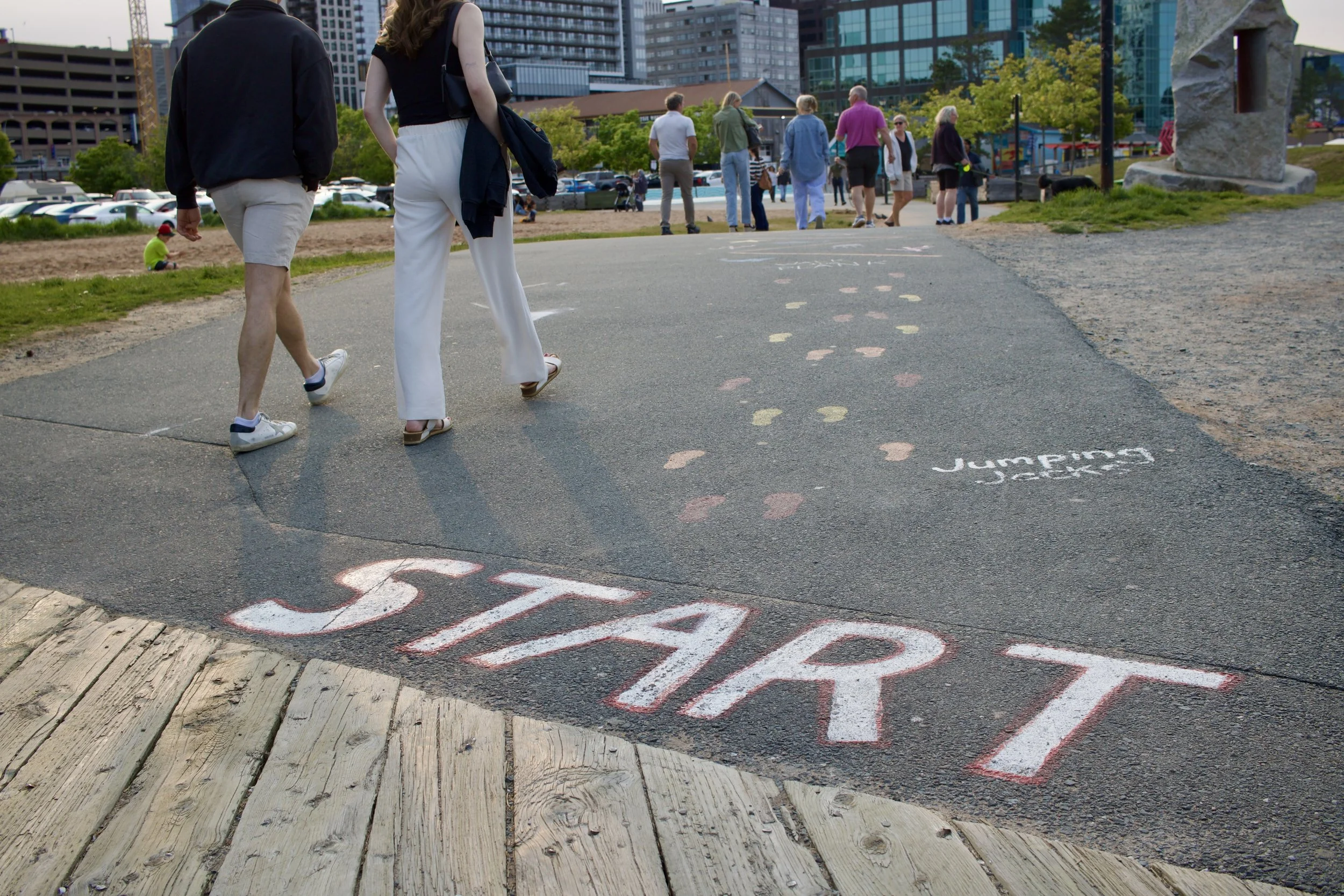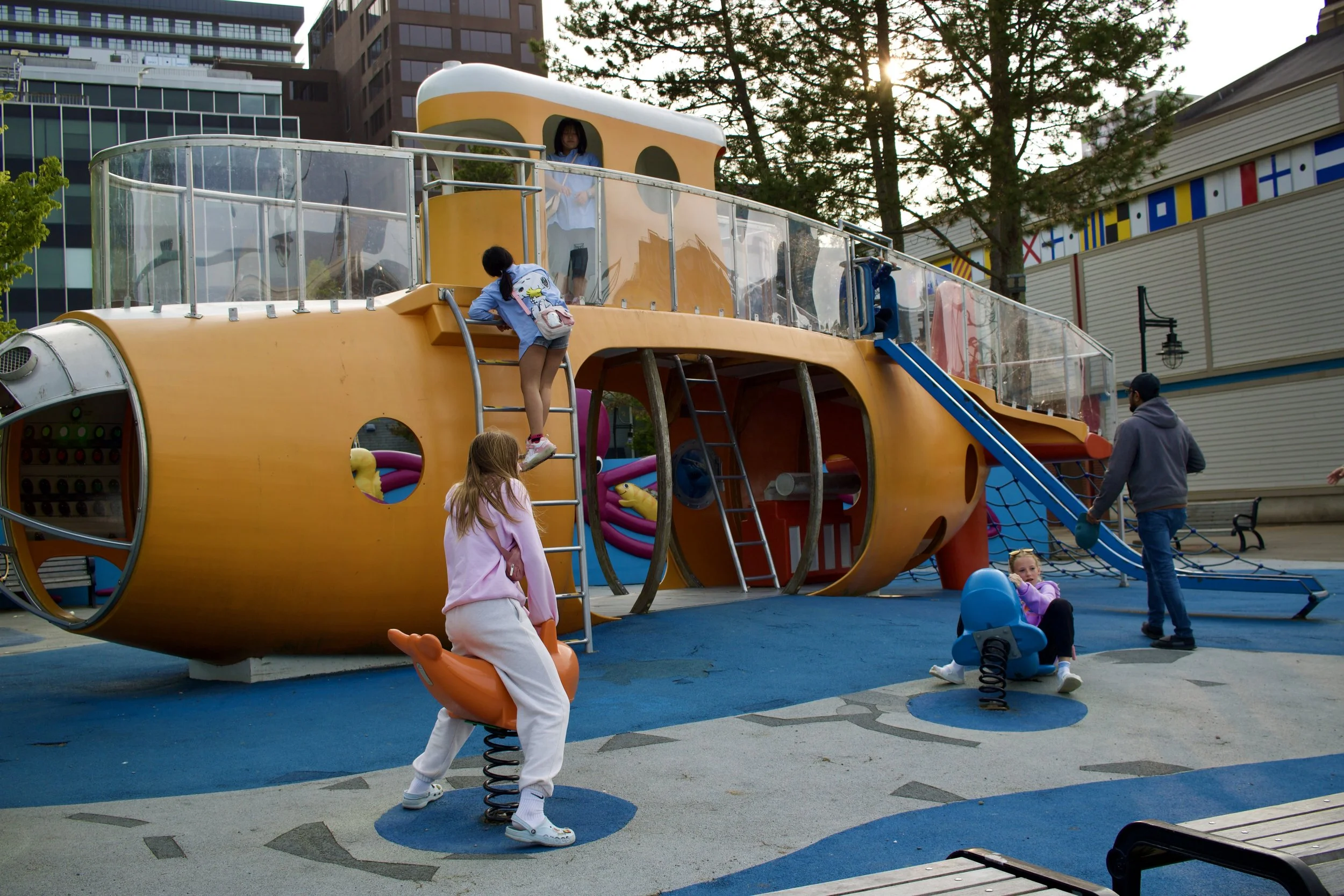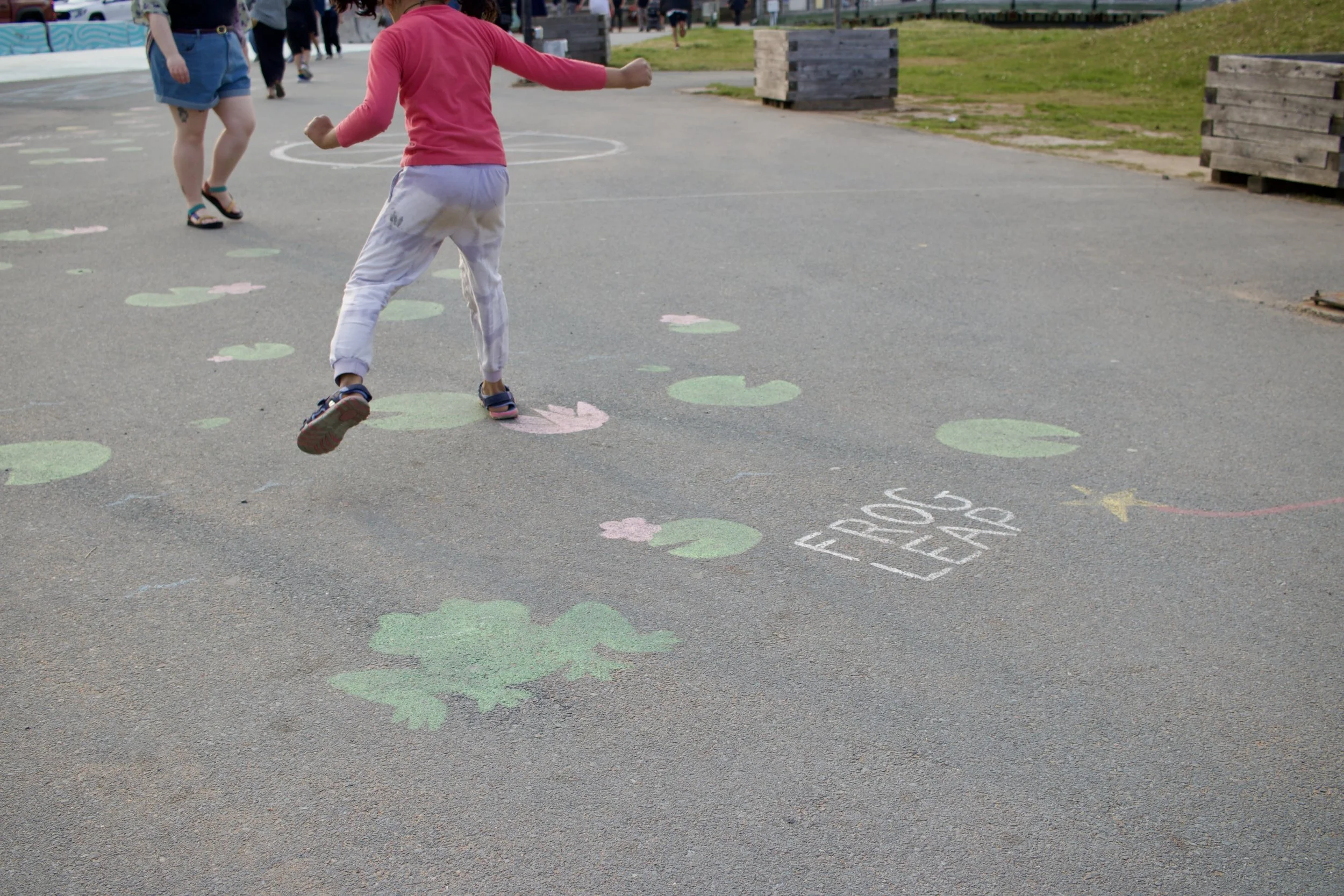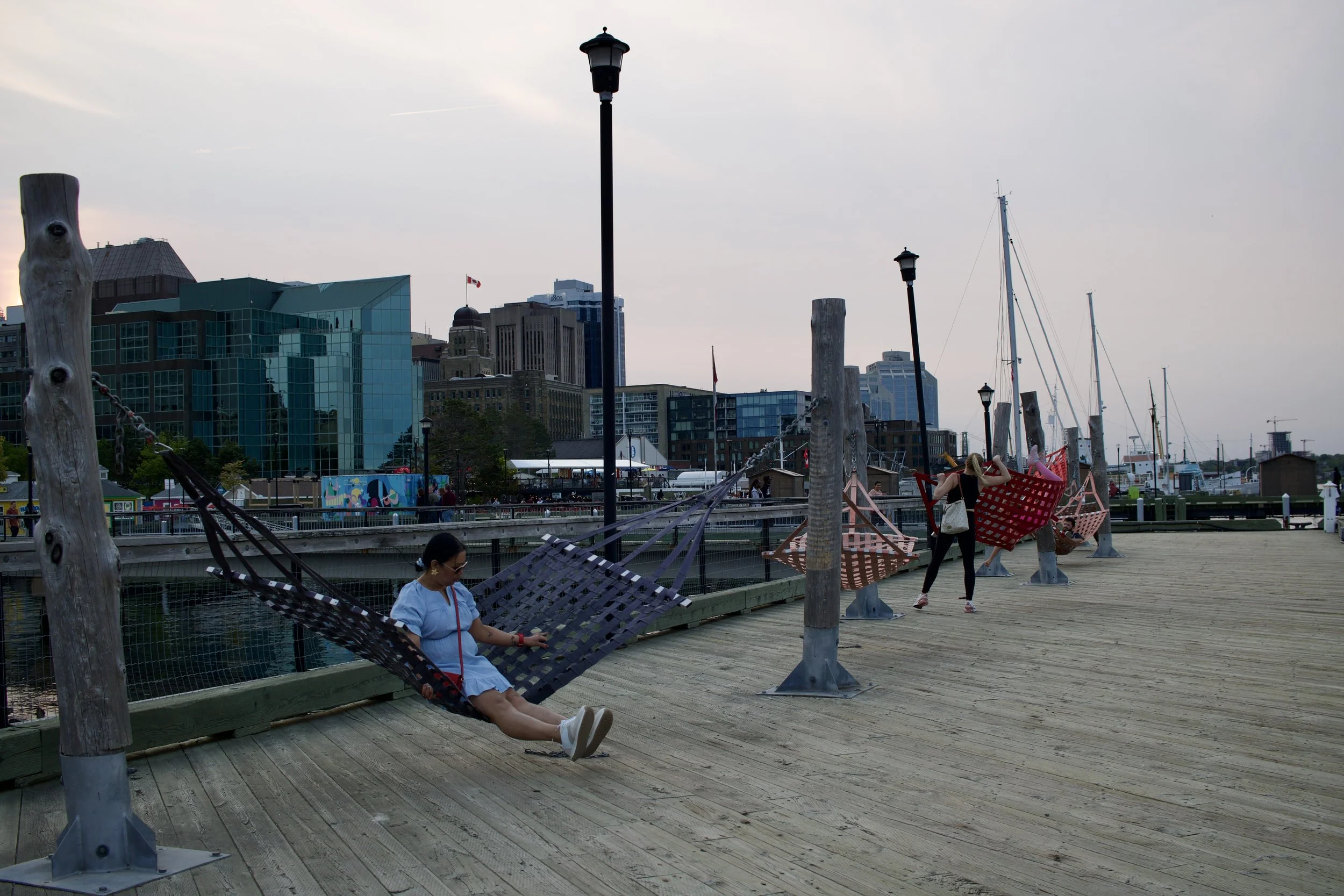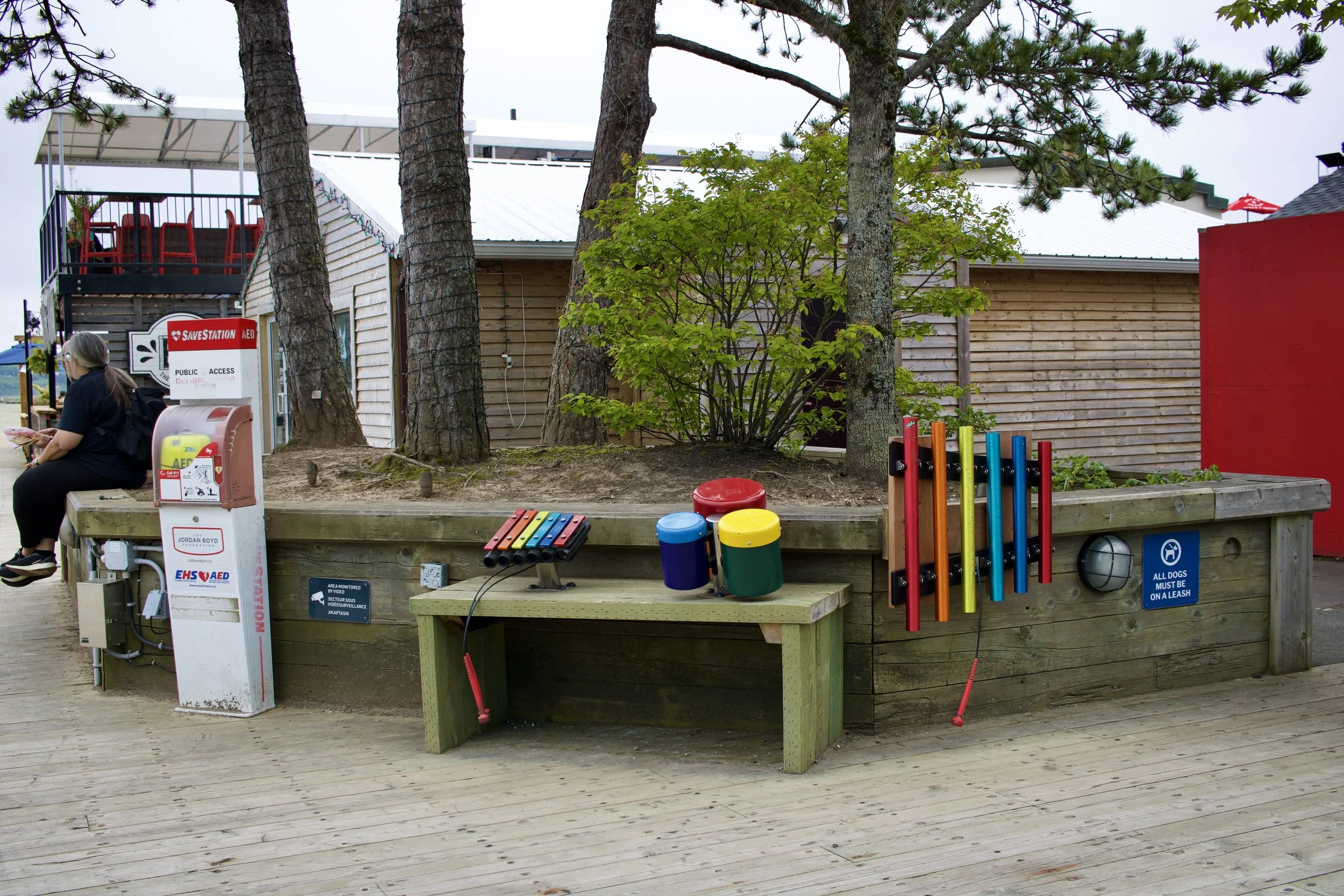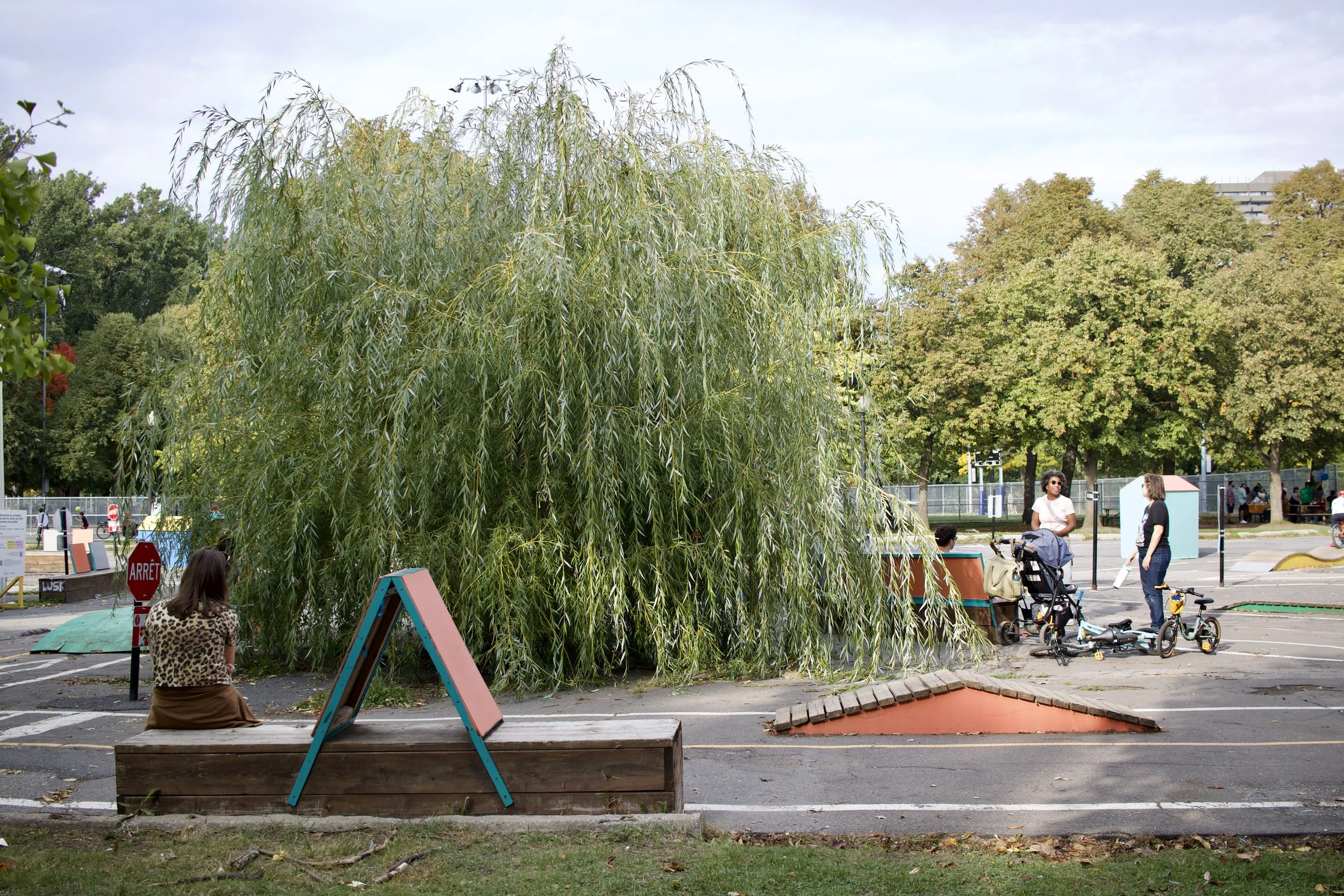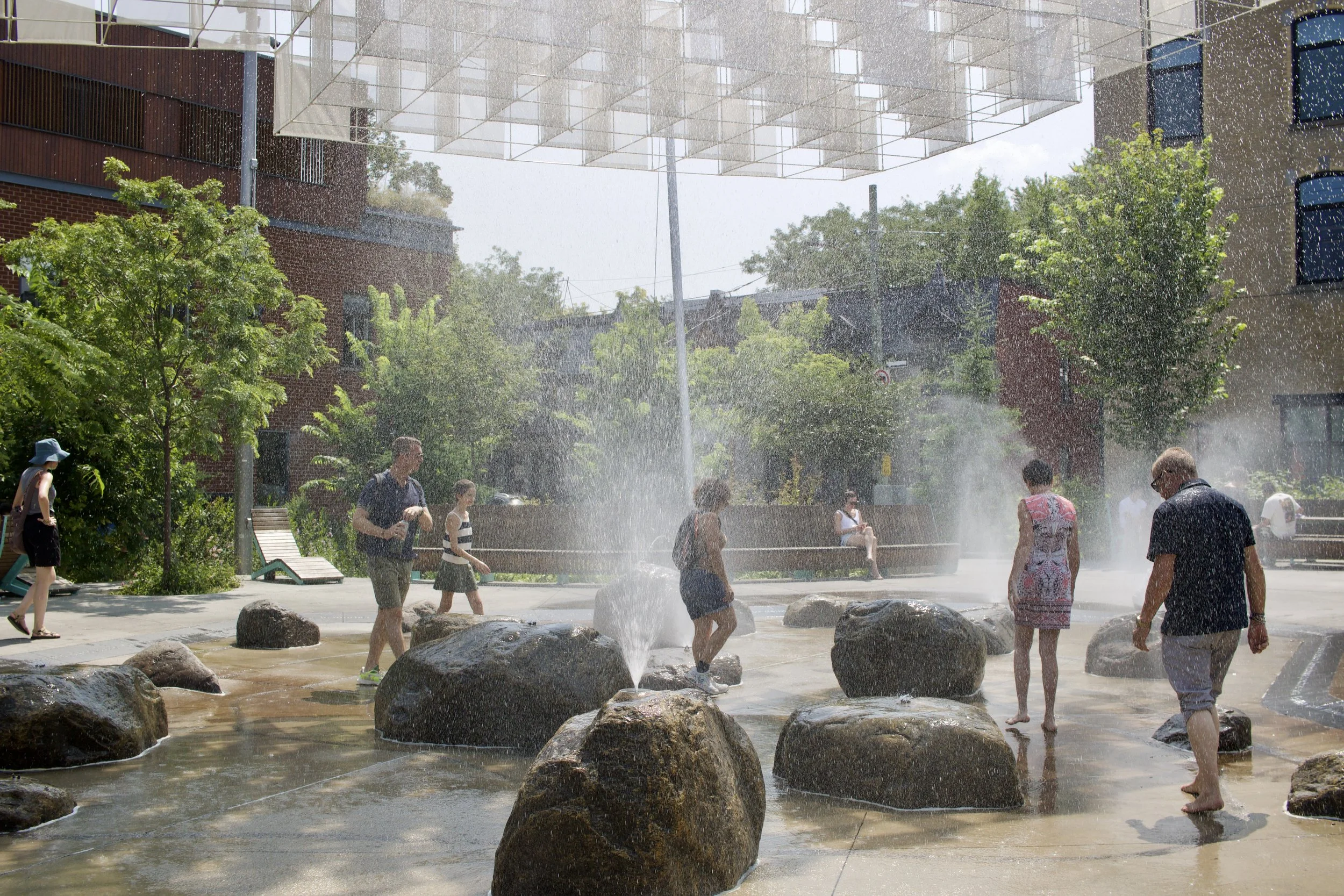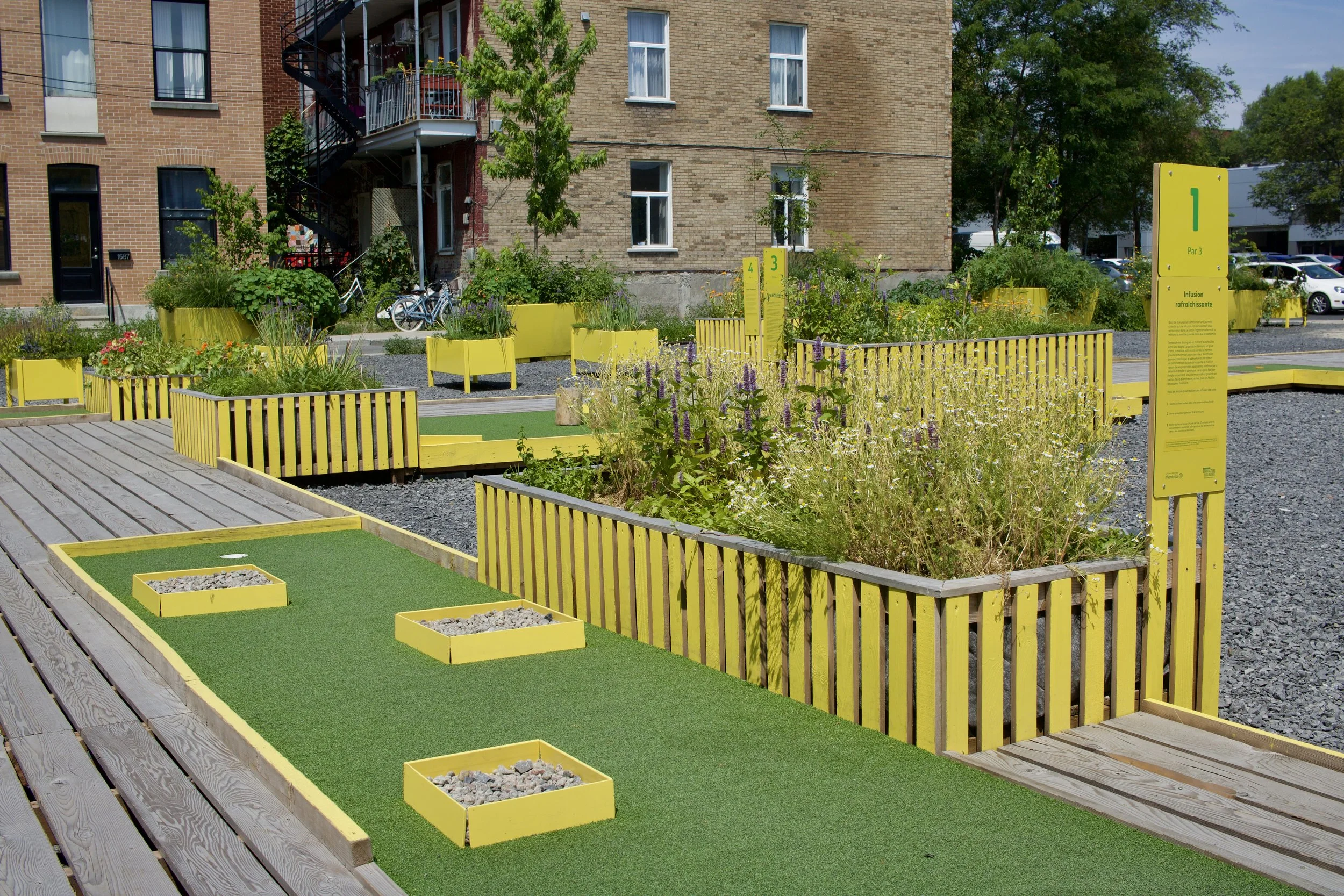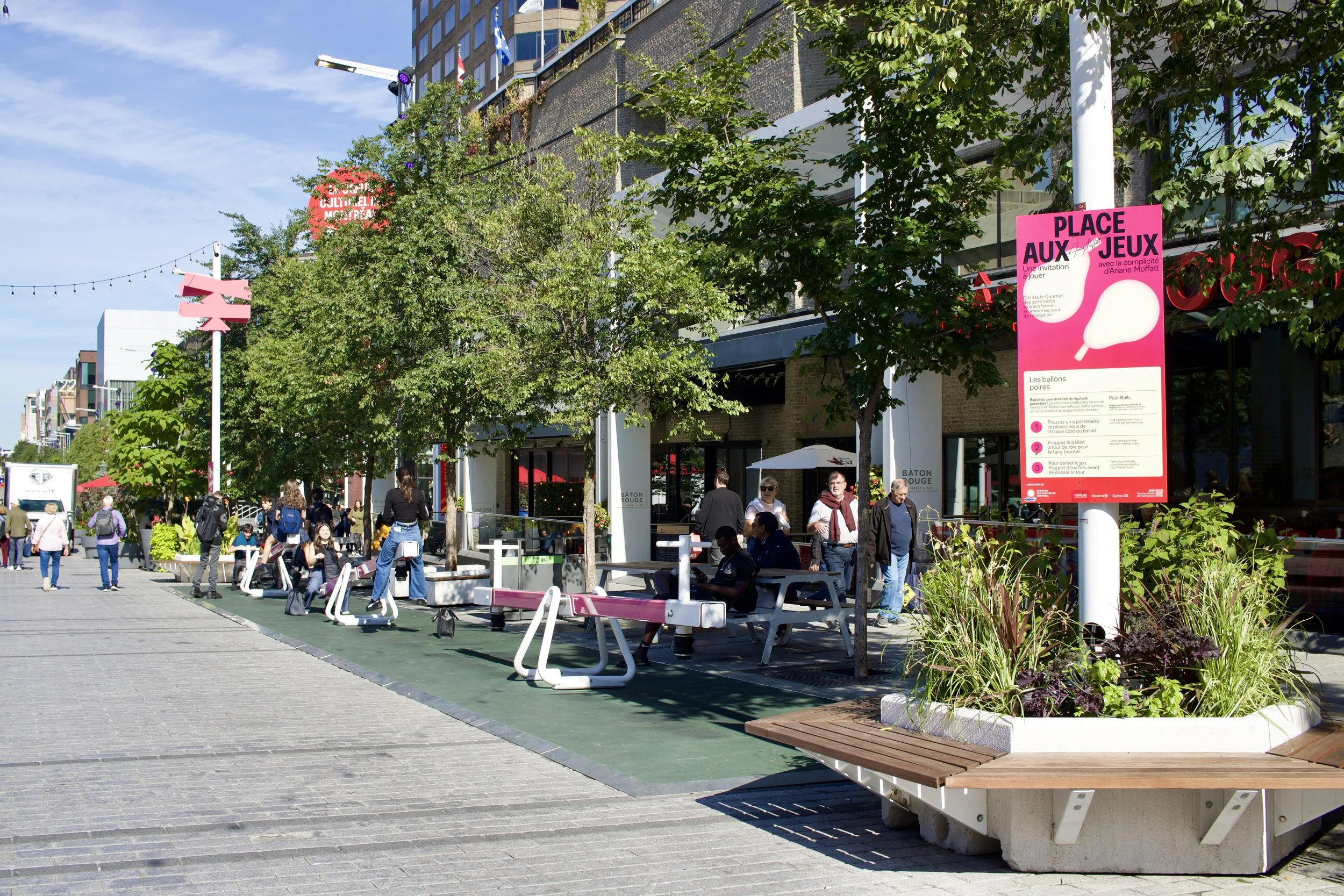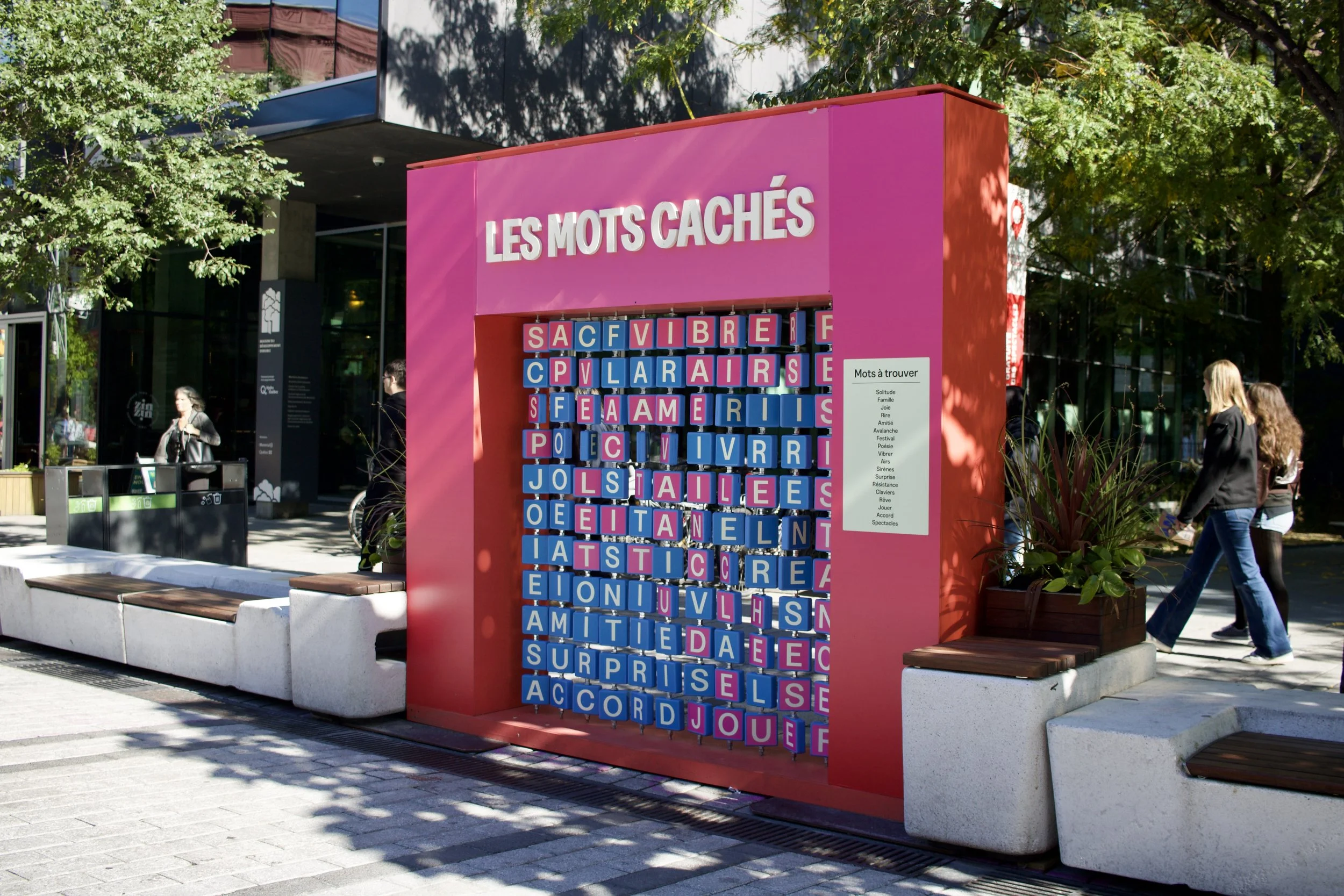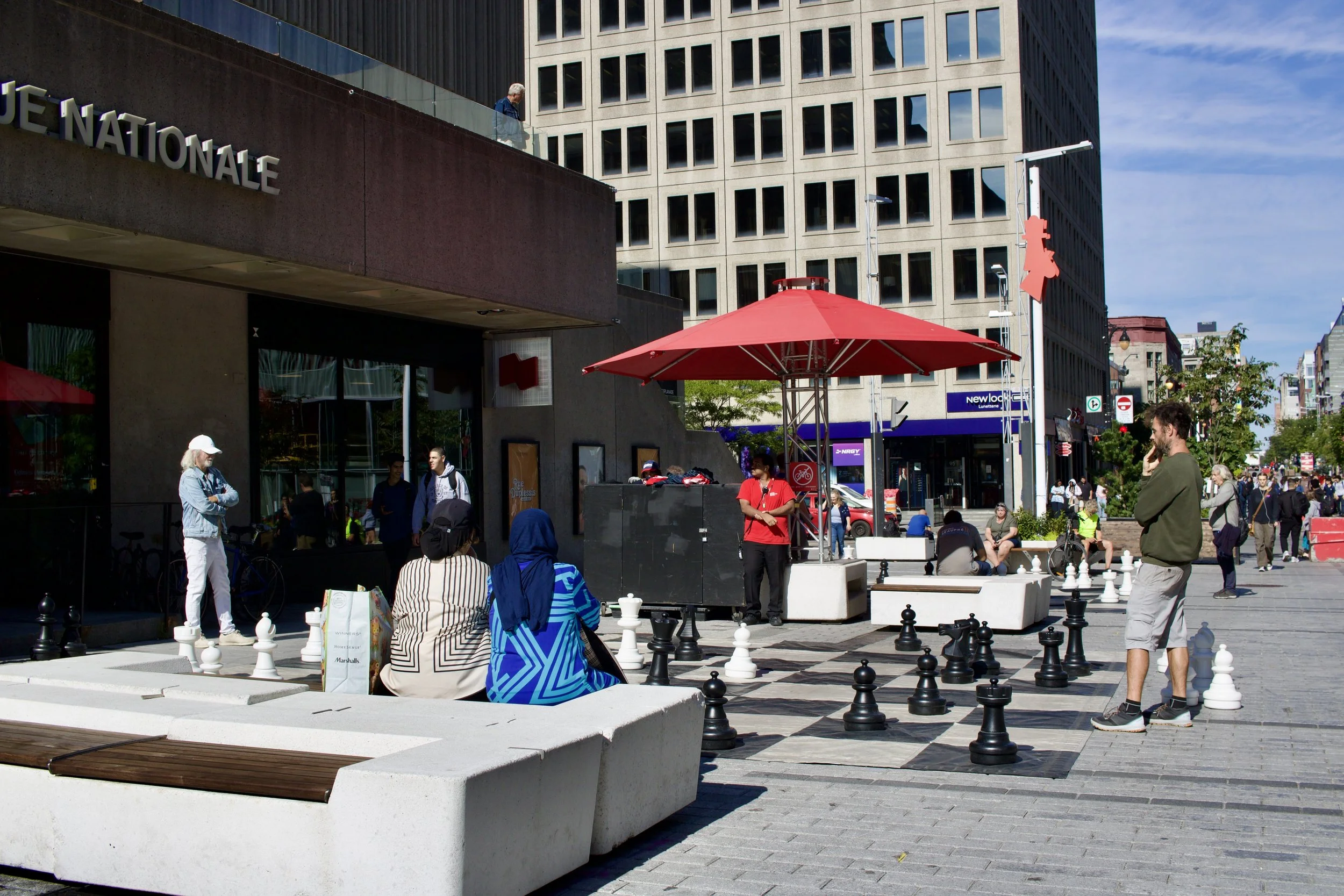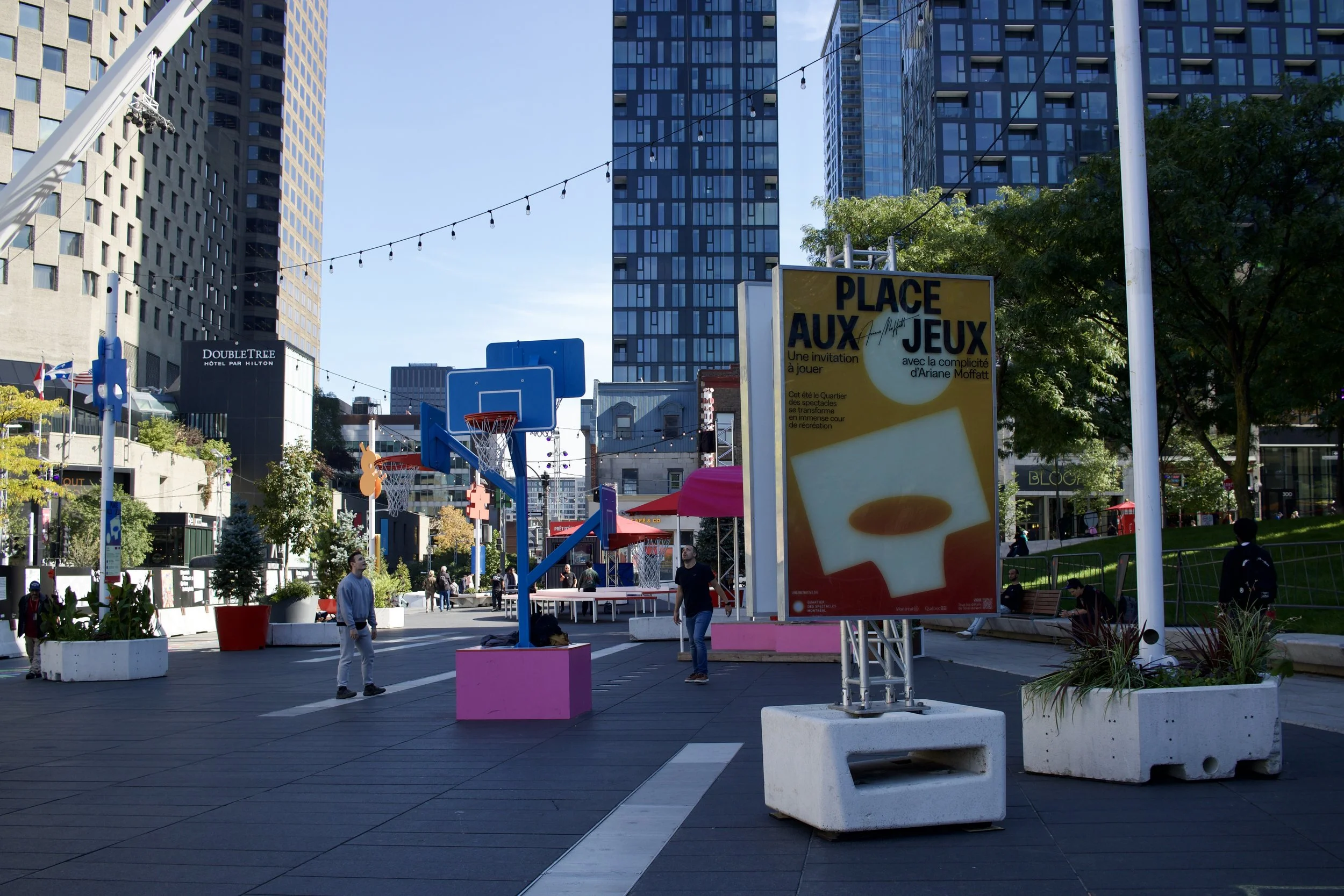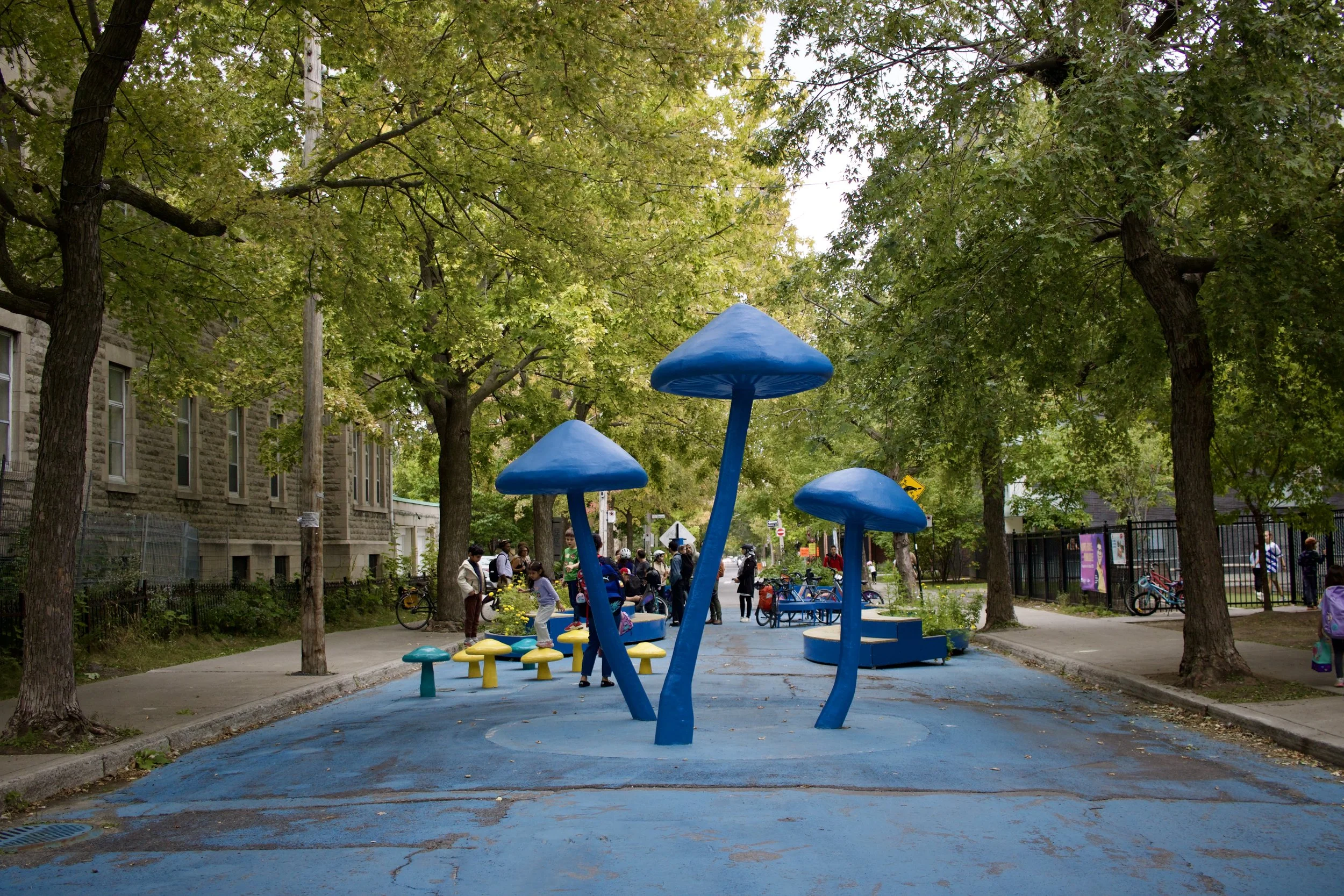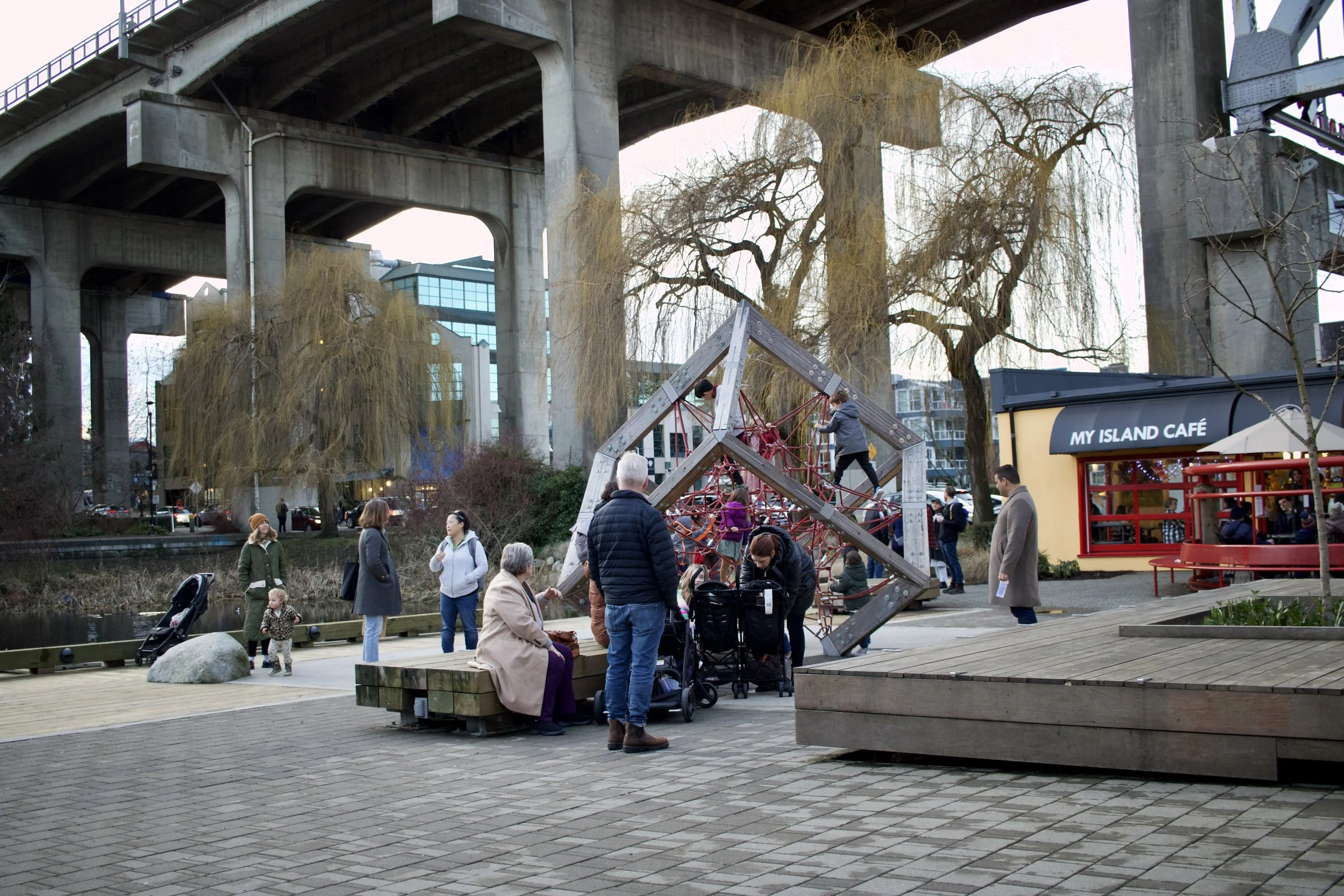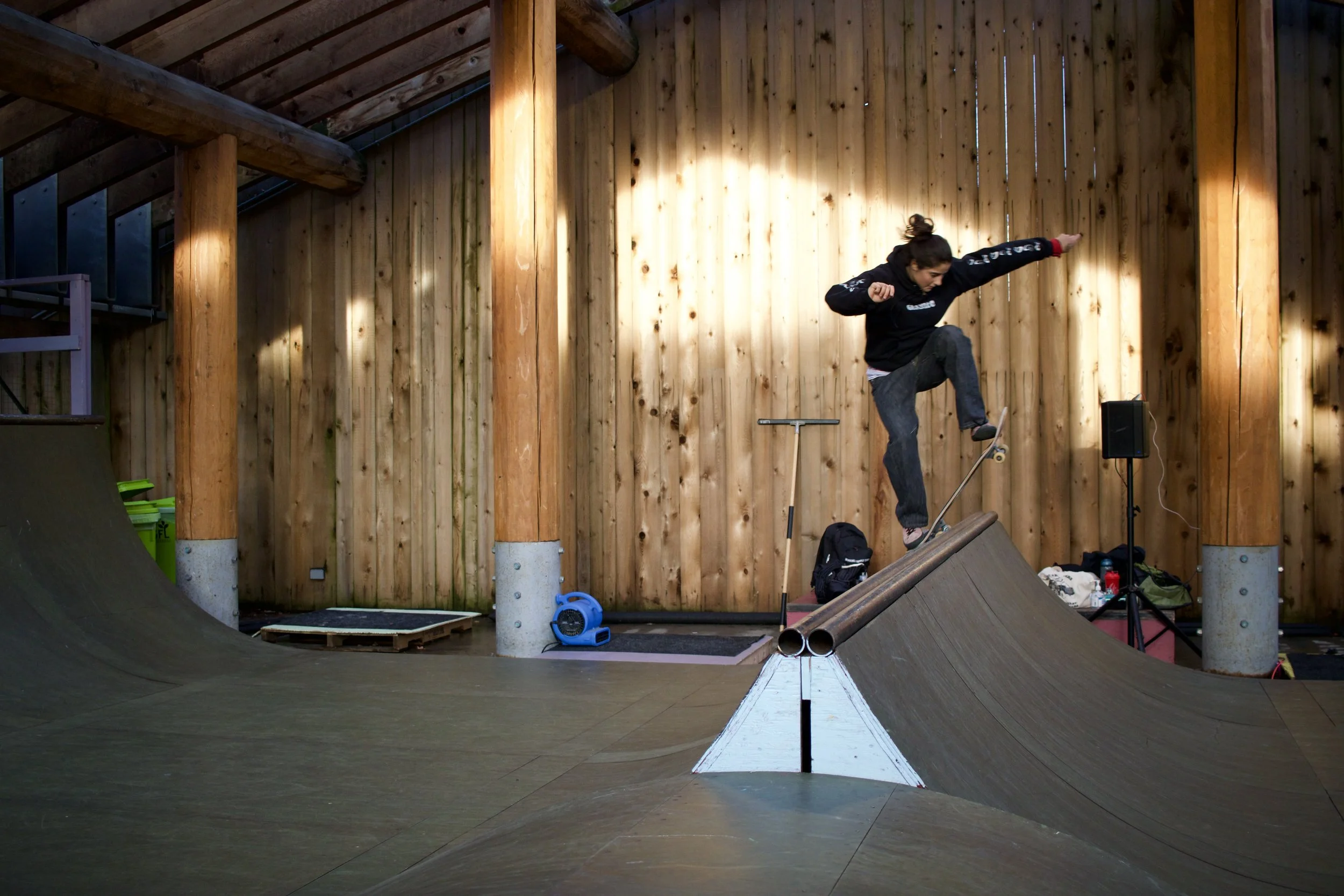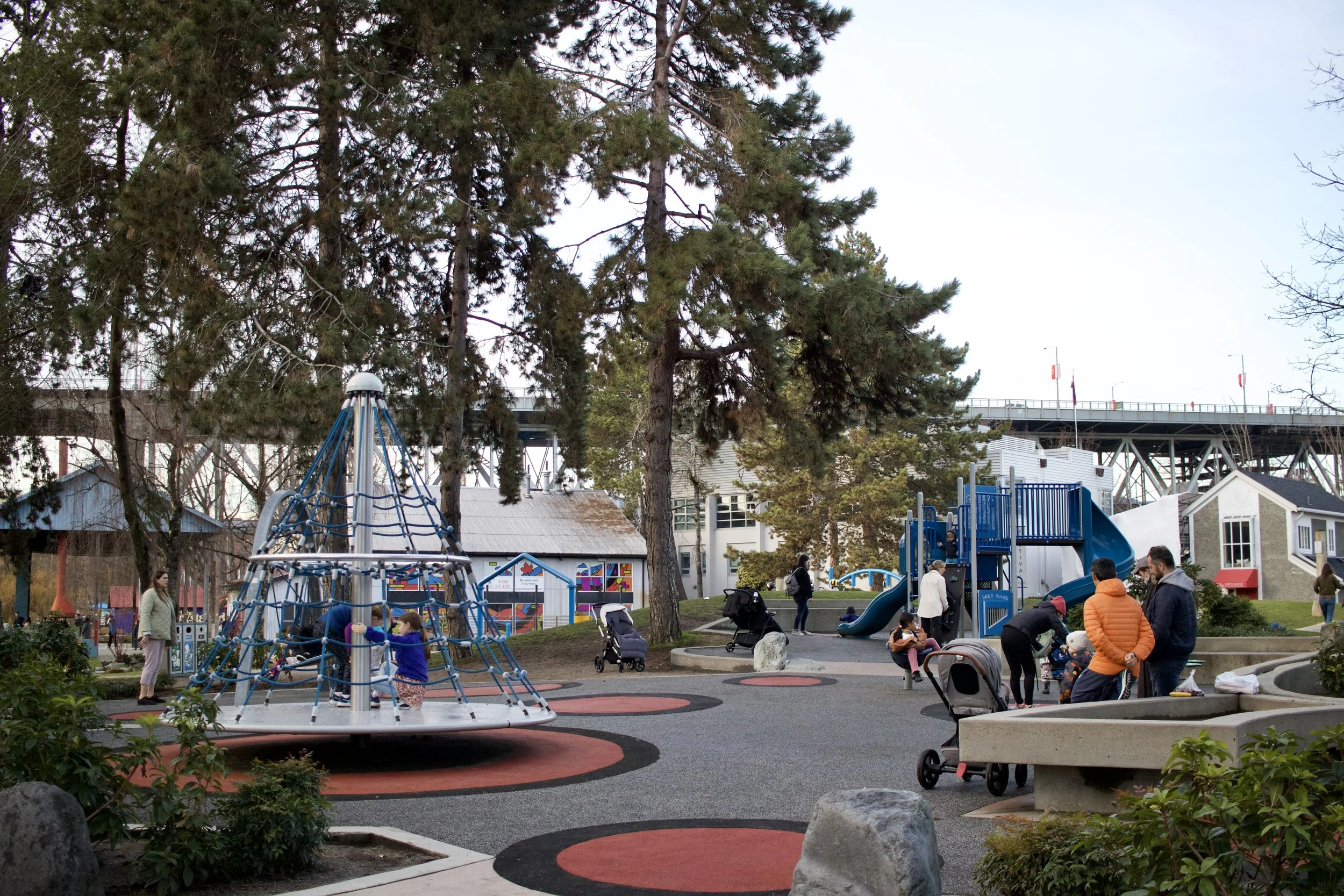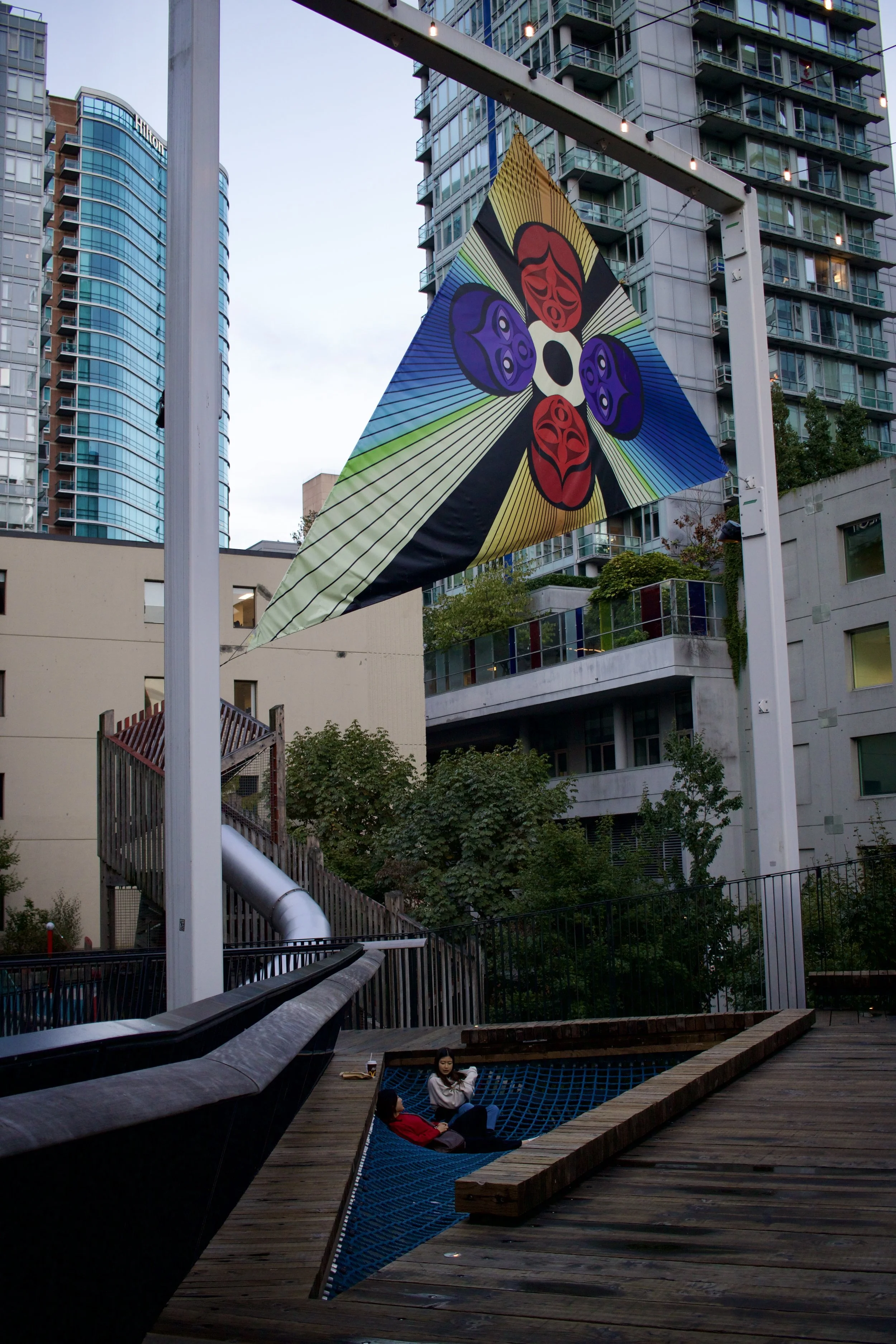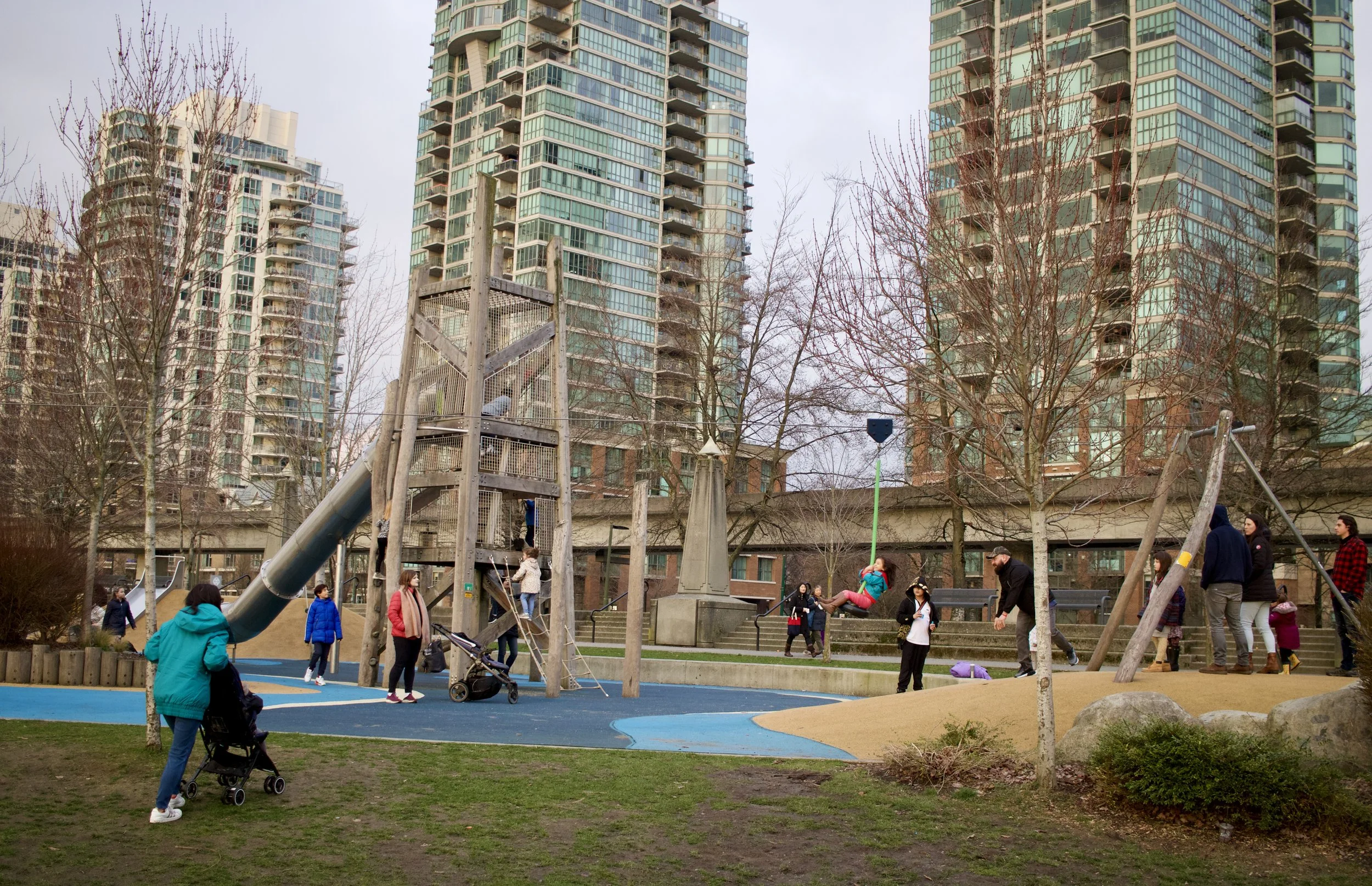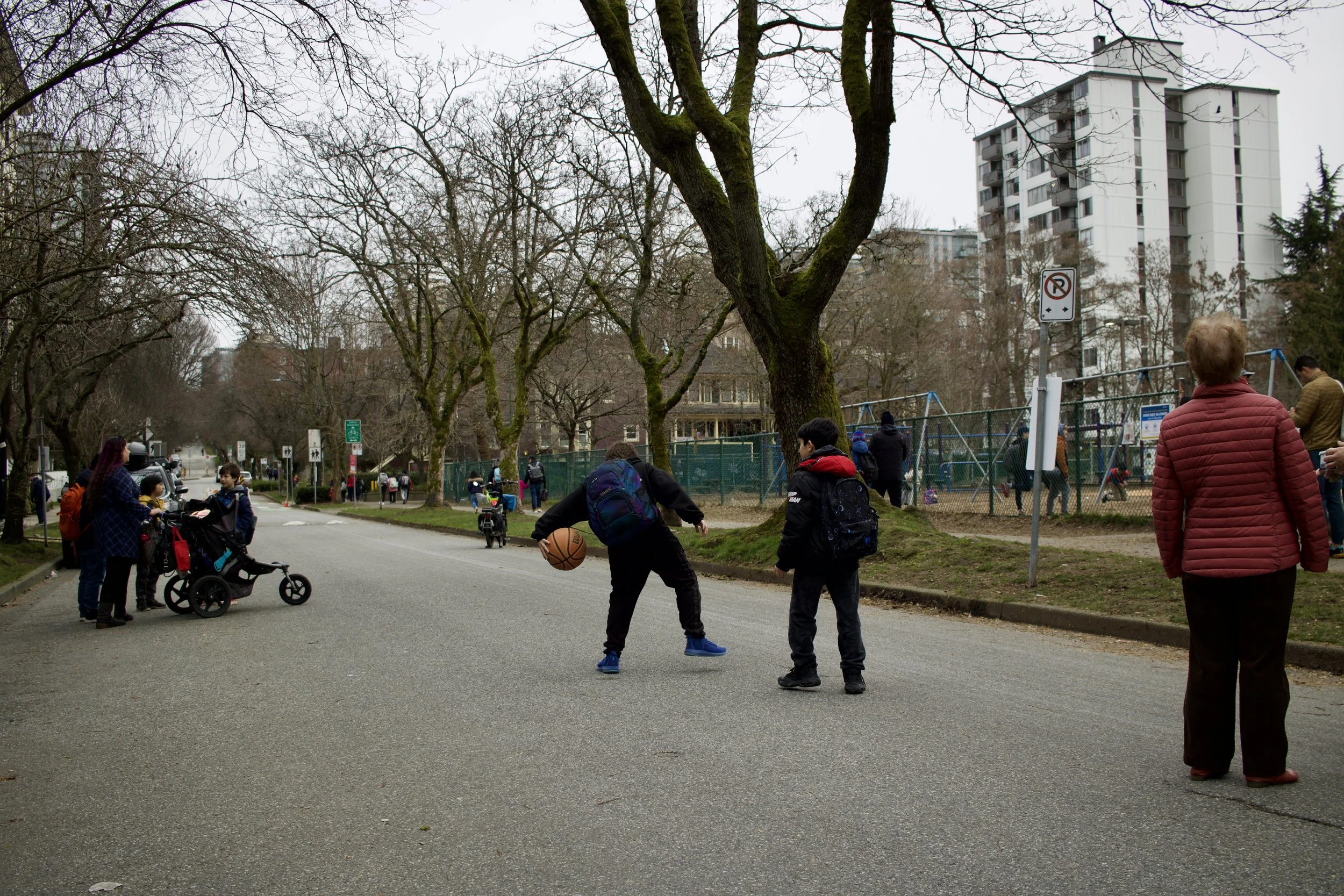How to Design Cities for Play
Children playing on “The Wave” art installation despite the prominent “do not climb” signage (photo taken by Nicole Roach in Halifax, Nova Scotia).
Everyone needs some play in their daily lives—from toddlers to teens to seniors. With more and more people in Canada living in urban areas, incorporating spaces for play into our cities is becoming increasingly important. This can include more parks and playgrounds (where play is typically expected), but it can also include unexpected spaces with interactive street art, lawn games, seesaws, and so much more!
This photo essay shares examples, from three cities across Canada, of the creative ways that they are incorporating play into their urban spaces—for the kid in everyone.
Halifax, Nova Scotia
The east coast city of Halifax has a historic downtown, beautiful parks, and a world famous waterfront. Halifax’s waterfront features a winding pathway that alternates between boardwalk, pavement, and piers. It includes a working port, local artisan stalls, seasonal vendors, and year-round businesses. It also incorporates plenty of fun along the route!
Start line art along a paved path (photo taken by Nicole Roach in Halifax, Nova Scotia).
Children playing in a “Submarine Playground” along Halifax’s waterfront. Local children helped create the concept for the octopus wall and submarine, which includes a slide, periscope, portholes, and a wheelchair accessible first level (photo taken by Nicole Roach in Halifax, Nova Scotia).
Child playing with Frog Leap interactive art along a paved path (photo taken by Nicole Roach in Halifax, Nova Scotia).
People relaxing and playing on public Waterfront Hammocks on Salter Boardwalk that enable swinging (photo taken by Nicole Roach in Halifax, Nova Scotia).
Colourful instrument installation along waterfront path (photo taken by Nicole Roach in Halifax, Nova Scotia).
Montreal, Quebec
Montreal is a leader in designing safe, inclusive, and beautiful public spaces. The City and community groups have been supporting plazas, pedestrianized streets, public art, game installations, and so much more to incorporate play into the every day. Place aux Jeux at Quartier des Spectacles is a notable example where the City collaborated with local artists to animate public spaces for festival-goers and visitors during the summer months.
Women sitting and standing as their children explore the “Jardin du petit monde à bicyclette” educational cycling park (photo taken by Nicole Roach in Montreal, Quebec).
Water spray feature in “Place des Fleurs-de-Macadam” parkett (photo taken by Nicole Roach in Montreal, Quebec).
Mini golf course in “Jardins du Petit-Laurier” corner lot (photo taken by Nicole Roach in Montreal, Quebec).
Young girls enjoying seesaws in the “Place Aux Jeux” installation (photo taken by Nicole Roach in Montreal, Quebec).
“Place Aux Jeux” installation featuring “Les Mots Cachés” word-finding game (photo taken by Nicole Roach in Montreal, Quebec).
Installation featuring large-scale chess games in pedestrianized street (photo taken by Nicole Roach in Montreal, Quebec).
“Place Aux Jeux” installation featuring basketball hoops, ping pong tables, and artwork (photo taken by Nicole Roach in Montreal, Quebec).
Permanent pedestrianized street “Place de L’Ange-Cornu” located in front of school, featuring mushroom art installations, seating, greenery, and lots of paint (photo taken by Nicole Roach in Montreal, Quebec via Green Communities Canada).
Vancouver, British Columbia
This west coast city prioritizes physical activity and access to nature. With a backdrop of the ocean, mountains, and towering trees, the city takes public parks and spaces for play seriously. This includes interactive playgrounds, School Streets, skate parks, and much more. This is especially true along the seawall, the longest uninterrupted waterfront path at 28 kms. This greenway offers incredible access to play throughout the city, from beautiful beaches to creative playgrounds.
Kids Market Courtyard playground with creative climbing structure on Granville Island (photo taken by Nicole Roach in Vancouver, British Columbia).
Publicly accessible indoor skatepark called the “Green Ramp” on Granville Island. It is operated during the winter months and is managed by volunteers from the Vancouver Skateboard Coalition (photo taken by Nicole Roach in Vancouver, British Columbia).
Playground in Sutcliffe Park with interactive features, including a spinning structure, slides, and bouncy ground (photo taken by Nicole Roach in Vancouver, British Columbia).
Young women enjoying rope net seating suspended over downtown’s “sθәqәlxenәm ts'exwts'áxwi7“ park (photo taken by Nicole Roach in Vancouver, British Columbia).
Playground in Creekside Park with climbing tower, swings, and zipline (photo taken by Nicole Roach in Vancouver, British Columbia).
Various types of swings, including one accessible, in Charleson Park Playground (photo taken by Nicole Roach in Vancouver, British Columbia).
Kids playing in year-round Comox School Street (photo taken by Nicole Roach in Vancouver, British Columbia).
We All Need More Play
Some people will make their own fun in their communities despite an uninspiring public realm, but not everyone can do that. Many need to feel invited to exist in public spaces, let alone spend time lingering and playing in them. This is especially true for women and marginalized people that may not feel fully welcomed or safe in shared environments.
That’s where prioritization of play and intentional urban design must come in – through funding, policies, and programming. We need more parks, more reclaimed streets, more recreational facilities, more community-based programming, more access to training and equipment, more games, more art, and many more reasons for public joy.
A few of the leading cities in Canada are incorporating these improvements in small, surprising ways (as demonstrated by this photo essay), but there is much more work to be done to make our cities truly designed for play.
So, let’s pick up our ping pong paddles, hula hoops, and paint brushes, and collectively make our public spaces a whole lot more fun.


